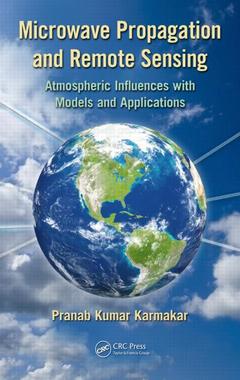Microwave Propagation and Remote Sensing Atmospheric Influences with Models and Applications
Auteur : Karmakar Pranab Kumar

Because prevailing atmospheric/troposcopic conditions greatly influence radio wave propagation above 10 GHz, the unguided propagation of microwaves in the neutral atmosphere can directly impact many vital applications in science and engineering. These include transmission of intelligence, and radar and radiometric applications used to probe the atmosphere, among others.
Where most books address either one or the other, Microwave Propagation and Remote Sensing: Atmospheric Influences with Models and Applications melds coverage of these two subjects to help readers develop solutions to the problems they present. This reference offers a brief, elementary account of microwave propagation through the atmosphere and discusses radiometric applications in the microwave band used to characterize and model atmospheric constituents, which is also known as remote sensing.
Summarizing the latest research results in the field, as well as radiometric models and measurement methods, this book covers topics including:
- Free space propagation
- Reflection, interference, polarization, and other key aspects of electromagnetic wave propagation
- Radio refraction and its effects on propagation delay
- Methodology of estimating water vapor attenuation using radiosonde data
- Knowledge of rain structures and use of climatological patterns to estimate/measure attenuation of rain, snow, fog, and other prevalent atmospheric particles and human-made substances
- Dual/multifrequency methodology to deal with the influence of clouds on radiometric attenuation
- Deployment of microwaves to ascertain various tropospheric conditions
- Composition and characteristics of the troposphere, to help readers fully understand microwave propagation
- Derived parameters of water, free space propagation, and conditions and variable constituents such as water vapor and vapor pressure, density, and ray bending
Outlines of Radio Waves and Troposphere. Propagation of Radio Waves: An Outline. Reflection and Interference of Radio Waves. Radio Refraction and Path Delay. Absorption of Microwaves. Rain Attenuation and Its Application at Microwaves. Attenuation by Hydrometeors Other than Rain. Appendix: Mean Atmospheric Temperature at Microwaves and Millimeter Waves in Clear Air Environment.
Pranab Kumar Karmakar obtained his MSc in physics in 1979 and PhD in the area of microwave propagation and remote sensing in 1990 from the University of Calcutta, India. Associated with the Department of Radiophysics and Electronics at Calcutta University since 1988, he is involved in both teaching and research work. He has more than forty-five publications in national and international journals of repute. Karmakaralso has more than thirty conference articles to his credit. He was awarded the Young Scientist Award of URSI (International Union of Radio Science) in 1990. He has been a visiting scientist at the Remote Sensing Lab, University of Kansas; Centre for Space Science, China; and Satellite Division, National Institute for Space Research (INPE), Brazil. He has also been awarded the South-South fellowship of TWAS (The Academy of Sciences for the Developing World) in 1997.
Karmakar’s current area of research includes microwave/millimeter wave propagation, microwave remote sensing, and atmospheric modeling.
Date de parution : 09-2011
15.6x23.4 cm
Date de parution : 04-2017
15.6x23.4 cm
Thèmes de Microwave Propagation and Remote Sensing :
Mots-clés :
Water Vapor Density; Integrated Water Vapor Content; Outlines of Radio Waves and Troposphere; Rain Rate; Propagation of Radio Waves: An Outline; Brightness Temperature; Reflection and Interference of Radio Waves; Water Vapor Content; Radio Refraction and Path Delay; Radiosonde Data; Absorption of Microwaves; Attenuation Function; Water Vapor; Atmospheric Refractivity; Specific Attenuation; Ground Wave; Rain Attenuation; Cloud Base Height; Radio Waves; Rain Height; Liquid Water Content; Sea Water; Earth Space Path; Isotropic Radiator; Water Vapor Attenuation; Aerosol Optical Depth; Fresnel Zone; Rain Cells; Rain Threshold; Drop Size Distributions



